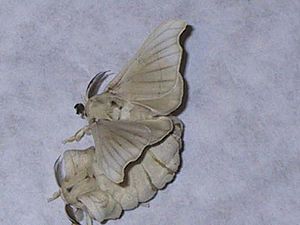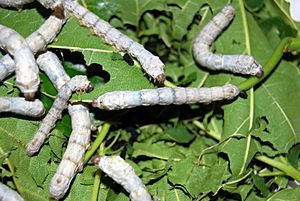Silkworm facts for kids
Quick facts for kids Silk Worm |
|
|---|---|
 |
|
| Paired male (above) and female (below) | |
 |
|
| Fifth instar silkworm larvae
Video: Metamorphosis/Life cycle of the Silkworm |
|
| Conservation status | |
| Scientific classification | |
| Kingdom: | |
| Phylum: | |
| Class: | |
| Order: | |
| Family: | |
| Genus: |
Bombyx
|
| Species: |
B. mori
|
| Binomial name | |
| Bombyx mori |
|
The silkworm is the larva or caterpillar of the Bombyx mori moth. Silk has been made for at least 5000 years in China. The moth is important because it makes silk. It is entirely dependent on humans, and it no longer lives in the wild. Silkworms eat mulberry leaves, and are native to northern China.
The domesticated B. mori and the wild Bombyx mandarina can still breed and sometimes produce hybrids.
Egg
The female silkworm lays about 300 eggs at a time. She lays eggs on the leaves of mulberry trees. The eggs are covered with gelatinous secretion by which they stick to the leaves. The female moth (silkworm) lays eggs and dies after laying eggs as she does not eat anything. The eggs are kept in a cool place so that they can be stored for a long time. In a favorable condition, they hatch into larvae. Larvae are produced in about 2 weeks from eggs at a temperature of 18 to 25 degree Celsius.
Silk
The cocoon is made of one thread of raw silk from 300 to 900 meters (1000 to 3000 feet) long. The fibers are very thin. About 2,000 to 5,000 cocoons are needed to make a pound of silk.
If the animal is allowed to survive after spinning its cocoon, it will make a hole in the cocoon when it exits as a moth. This would cut the threads and ruin the silk. Instead, silkworm cocoons are thrown into boiling water, which kills the silkworms and also makes the cocoons easier to unravel. Often, the silkworm itself is eaten.
The adult silkworms (moths) cannot fly. The silkworm-moths have wings about 2 inches wide and a white hairy body. Females and males are similarly colored. Adult silkworms have small mouths and do not eat.
Silkworm Legends
In China, there is a legend that the discovery of the silkworm's silk was first invented by the wife of the Yellow Emperor, Leizu around the year 2696 BC. According to the book written in the 13th century, she was drinking tea under a tree when a cocoon fell into her tea. She picked it out and as it started to wrap around her finger, she slowly felt something warm. When the milk ran out, she saw a small cocoon. In an instant, she realized that this cocoon was the source of the silk. She taught this to the people and it became common. There are many more legends about the silkworm.
Khotan is an oasis, located on the southern edge of Taklamakan Desert, and was one of the first places outside of inland China to begin cultivating silk. In the far past, the Chinese guarded their knowledge of silk. It is said that a Chinese princess smuggled eggs to Khotan, hidden in her hair. After this, the way to cultivate silk was transmitted to the Western Asia, and also Europe.
The Japanese also love silk and started cultivating and weaving silk in the earlier age than the western countries. According to the Records of the Three Kingdoms, a history book published in the 3rd century, Japan exported silk to Wei, a kingdom in the northern part of the China mainland, in the 2nd century. It takes 5000 silkworms to make a single kimono.
Related pages
- Sericulture - producing silk fibers by raising silkworms; also called "silk farming"
Images for kids
-
A study of an egg of a silkworm from Hooke's Micrographia, 1665
-
1679 study of the silkworm metamorphosis by Maria Sibylla Merian, it depicts the fruit and leaves of a mulberry tree and the eggs and larvae of the silkworm moth.
-
Gold silkworm, Han dynasty
See also
 In Spanish: Gusano o mariposa de seda para niños
In Spanish: Gusano o mariposa de seda para niños










